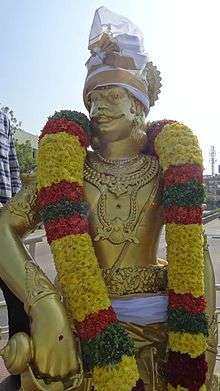Muthuraja
| Muthuraja | |
|---|---|
 Perumpidugu Mutharaiyar II alias Suvaran Maran 675 AD - 745 AD |
Mutharaiyar or Muthuraja are Tamil-speaking community of landowners.[1] Mutharaiyars ruled over Kaveri Delta Region before the Cholas. Mutharaiyar (AD 610 - AD 851) earlier were a line of kings and were for a long time feudatory to the Pallavas, ruling part of Tamil Nadu in Southern India.
Origin
Nāladiyār
During the pre-Chola period, the chiefs of the Muthuraja/Mutharaiyar community ruled over the Tanjore district in Tamilakkam. They controlled the fertile plains of the Kaveri region.[2] When the Cholas came to power, the Muttaraiyar were turned into feudatories. Muttaraiyar literally means King of three territories.[3] They built many temples for Siva.[4] One of the most famous from this clan was Peru Mutharaiyar, who was known for his great wealth and grand feasts. Two stanzas (200, 296) of Nāladiyār, one of the works of ancient Tamil literature, is dedicated to him.[5][6] One of their titles was Lord of Tanjore.[7][8]
During the period of Ko Rajakesarivarman Rajaraja Chola I, we know of at least one high ranking chief and a feudatory of the Chola from this community: Śēkkizhār Araiyan Sankaranarayanan, also known as Chola-Muttaraiyan. Araiyan, which is the Tamil equivalent of the Sanskrit Raja or King, in this context means a chieftain or a governor.[9] The title Chola Muttaraiyan means that he was a subordinate of the Chola ruler and was the Lord of the Mutharaiyar people.
Paluvettaraiyar regiment
Paluvettaraiyar regiment, was a military regiment maintained by Mutharaiyar chief Paluvettaraiyar, which besides Mutharaiyar/Muthuraja soldiers, also employed Senaithalaivar /Sengunthars as soldiers[10] in the regiment of Paluvettaraiyar and were involved in the invasion of Sri Lanka by Cholas in the 10th century.[11][12]
See also
References
- ↑ page number 85 of Book "Caste, Class, and Power: Changing Patterns of Stratification in a Tanjore Village" http://books.google.co.in/books?id=lbnYaLGWnr8C&pg=PA125&dq=srirangam+caste+acres&hl=en&sa=X&ei=b7U8U7OdAe2h7Ab2p4DoCQ&ved=0CC4QuwUwAA#v=onepage&q=caste&f=false
- ↑ The political structure of early medieval South India, page 112
- ↑ Journal of Indian history, Volume 19, page 40
- ↑ Early Chōl̤a art:origin and emergence of style
- ↑ History of Tamil language and literature:beginning to 1000 A. D., page 89
- ↑ Tirupati Balaji was a Buddhist shrine
- ↑ The History and Culture of the Indian People: The classical age
- ↑ Indian archaeological heritage: Shri K.V. Soundara Rajan festschrift, Volume 1, page 32
- ↑ Ramaswamy, V. (1985). Textiles and weavers in medieval South India. Oxford University Press. Retrieved 2015-04-05.
- ↑ Studies in Indian epigraphy , Volumes 26–27
- ↑ Historical perspectives of warfare in India: some morale and matérial determinants By Sri Nandan Prasad, Centre for Studies in Civilizations (Delhi, India)